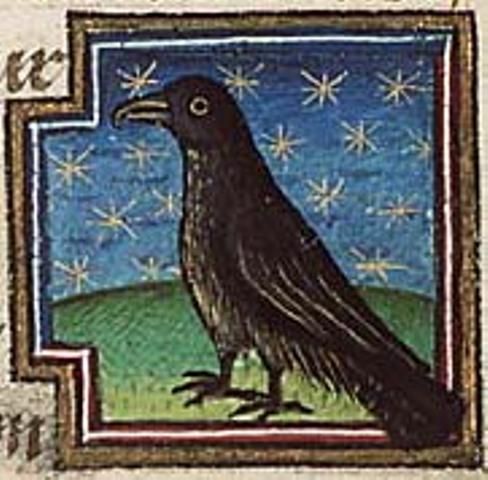















Boneddy y Gwyr Gogledd
The Descent of the Men of the North
This genealogical tract appears in several manuscripts, particularly Peniarth MS 45, dating to the thirteenth century, but possibly a copy of a twelfth century text. It records the pedigrees of the northern kings of Celtic Britain in the sixth century, that is, the time of Arthur and afterwards, when Britain fell to the Saxons.
Vryen m. Kynuarch m. Meirchawn m. Gorust Letlwm m. Keneu m. Coel
Llywarch Hen m. Elidyr Lydanwyn m. Meirchawn m. Gorust Ledlwm m. Keneu m. Coel
Clydno Eidin & Chynan Genhir & Chynuelyn Drwsgyl, Kynvawr Hadgaddvc & Chatrawt Calchuynyd, meibon Kynnwyt Kynnwydyon m. Kynuelyn m. Arthwys m. Mar m. Keneu m. Coel
Dunawt & Cherwyd & Sawyl Pen Uchel meibyon Pabo Post Prydein m. Arthwys m. Mar m. Keneu m. Coel
Gwrgi & Phered meibon Eliffer Gosgord Uawr m. Arthwys m. Mar m. Keneu m. Coel
Gwendoleu & Nud & Chof meibyon Keidyaw m. Arthwys m. Mar m. Keneu m. Coel
Trychan cledyf Kynuerchyn a thrychan ysgwyt Kyrtnwdyon a thrycha wayw Coeling; pa neges bynhac yd elynt iddi yn duun, nyt amethei hon honno
Ryderch Hael m. Tutwal Tutelyt m. Kedic m. Dyuynwal Hen Mordaf m. Seruan m. Kedic m. Dyfynwal Hen
Elffin m. Gwydno m. Cawrdaf m. Garmonyawn m. Dyfynwal Hen
Gauran m. Aedan Uradawc m. Dyuynwal Hen m. Idnyuet m. Maxen Wledic, Amherawdyr Ruuein
Elidyr Mwynuawr m. Gorust Priodawr m. Dyfynwal Hen
Huallu m. TutuwIch Corneu, tywyssawc o Kernyw, & Dywanw merch Amlawt Wledic y uam
It is translated as:
Urien son of Cynfarch son of Merchion son of Gorwst Lledlum son of Ceneu son of Coel.[1]
Llywarch Hen son of Elidyr Lydanwyn son of Meirchawn son of Gorust Ledlwm son of Keneu son of Coel.[2]
Clydno Eidin & Chynan Genhir & Chynuelyn Drwsgyl, Cynfawr Hadgadduc & Chatrawd Calchuynyd, are the sons of Cynnwyd Cynnwydyon son of Cynfelyn son of Arthwys son of Mar son of Keneu son of Coel.[3]
Dunawd & Cherwyd & Sawyl High-head are the sons of Pabo the Pillar of Britain son of Arthwys son of Mar son of Keneu son of Coel.
Gwrgi & Peredur are the sons of Eliffer of the Great Retinue son of Arthwys son of Mar son of Keneu son of Coel.[4]
Gwendoleu & Nudd & Chof the sons of Ceidyaw son of Arthwys... etc.[5]
The 300 swords of the Cynferchyn, and the 300 shields of the Cynwydion, and the 300 spears of the Coeling; on whatever expedition they might go together, they would never fail. --Thanks go to Darrel Wolcott for this translation
Rydderch Hael son of Tudwal Tudelyd son of Kedic son of Dyuynwal Hen. [6]
Mordaf son of Seruan son of Kedic son of Dyfynwal Hen.
Elffin son of Gwyddno son of Cawrdaf son of Garmonyawn son of Dyfynwal Hen.[7]
Gabhran son of Aedan Uradawc son of Dyuynwal Hen son of Idnyued son of Warlord Maxen, Emperor of Rome.[8]
Elidyr Mwynuawr son of Gorust Priodawr son of Dyfynwal Hen
Huallu son of Tudfwlch Corneu, prince of Cornwall, & Dywanw daughter of Amlawdd Wledic.[9]
NOTES
1. Urien is Urien of Rheged, Uriens of Gorre in Arthurian Romance. Merchion is also the father of King Mark of the Tristan and Iseult tale; and Coel is Old King Cole.
2. Llywarch was not only a chieftan, but is credited with several poems in both the Red Book of Hergest and the Black Book of Carmarthen.
3. Cynfelyn is the same name as Cymbeline, but this is a much later person than the historical/literary figure.
4. Peredur is usually identified with the figure of the eponymous Welsh romance from The Mabinogion, which identifies him with Sir Perceval the Grail knight.
5. Gwendoleu was the pagan king defeated by Rhydderch Hael, Aedan macGabhran and Peredur at the Battle of Arthuret.
6. Rhydderch Hael, in the Vita Merlini, is also said to be the brother-in-law of Myrddin.
7. Elffin is the same as Elphin to whom Taliesin was bard in the romance Hanes Taliesin. His father is Gwyddno Garanhir, whose kingdom, according to legend, sunk into the sea at Cardigan Bay.
8. Here the order has been reversed, a mistake saying that Gabhran is the son of Aedan, while it was Aedan who was the son of Gabhran. Aedan actually had a son named Arthur, and some believe this was the real King Arthur; yes or no, Gabhran was a Scot, which at this time meant Irishman, particularly from Ulster. As for Maxen, he is the same as the Breuwydd Macsen or "Dream of Maxen" from The Mabinogion.
9. Dynwanw is the sister of Eigyr, the Welsh Igrain, the mother of Arthur.
Translation: Mary Jones © 2004